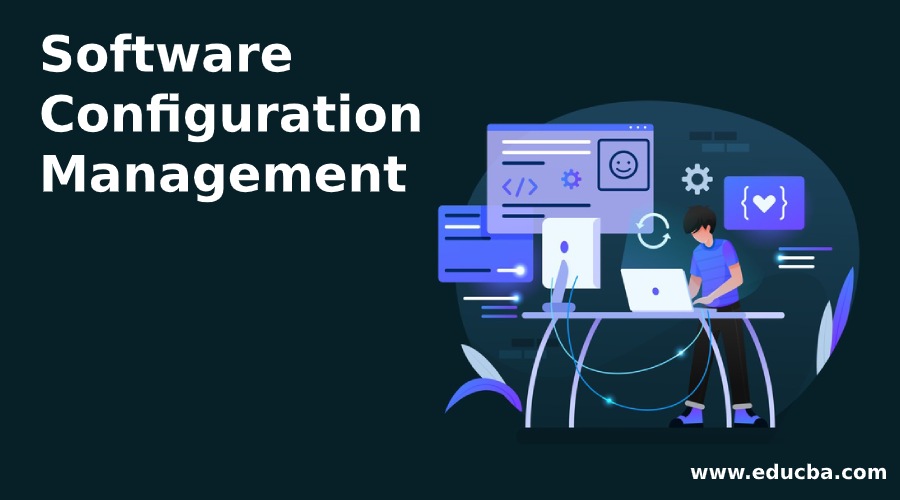Updated April 3, 2023
Introduction to Software Configuration Management
Software Configuration Management (SCM) is a branch of Software Engineering to provide a better process to handling, organizing and controlling the changes in requirements, codes, teams and other elements in the software project development life cycle. The SCM primarily deals with version selection, tracking the changes and version control of software projects with high productivity and minimize the error or risk factor.
Why do we need Software Configuration Management?
It has the following pros to choose as a software configuration management tool in software project development. Such as,
- Tracking and managing the changes in the software development process.
- It provides to enhance the Productivity of the software application with minimal error.
- It provides a smooth workflow inside the development process.
- Easy to communicate with team members to develop a better quality of the product.
- To track every member of the team with project workflow status.
- It updates each team member’s code parallelly by considering different version control.
- To manage the different tools and development processes in a software product.
- It is used to managing the software and hardware inside the application.
- It is used to controlling and managing defects, teamwork and process.
- It handles the software budgeting as per the change in the application.
How does Software Configuration Management work?
A software configuration process is a tool used in the software development life cycle process to track, changing and managing the configuration items (requirements, codes, documents, defects, resources, budgeting, software, hardware, etc) inside the product development. The project manager, developers, configuration manager, the product owner and testers are involved in the SCM process.
It has multiple processes to complete software configuration management. Such as:
- Planning and Identification Process
- Version Control Process or Baselines
- Change Control Process
- Configuration Release Process
- Configuration Auditing Process
- Review and Status Reporting Process
1. Planning and Identification Process
This is the initial level of the SCM process to planning properly for the development of the application and identifies the configuration items as per the scope of the project. To conduct kick-off meetings or start meeting and welcome to change requests are the basic criteria for this process. The project management plan is the input for this process and approval of the plan is the exit criteria.
2. Version Control Process or Baselines
The version control or baselines indicates to store the different versions of development/configuration by changing the scope or requirements or code or software environment. This process provides several versions of that software product.
3. Change Control Process
n this process the new change request created by the client to change some configurations on the software product i.e. to add or remove or edit on the configuration items as the request is received by the team. As per approval of the change request the application will develop and the request will be closed on status.
4. Configuration Release Process
This process is used to ensure the application will develop as per the project plan and test/verify the application as per scope. The software-related documents and software release notes are the inputs to provide a working version of the software application.
5. Configuration Auditing Process
In this process to verify the developed software product as per the baselines or not. Here we go for function requirement audit and physical audit of the software application.
6. Review and Status Reporting Process
It is a technical review on the application workflow, process, configuration items, and change requests, etc to generate the status report in every phase of the software development life cycle process. In this process we go for multiple reviews of the application to develop some application-related documents like user manual, Installation process guide, Do’s and Don’t Do’s, Release notes, etc.
Advantages and Disadvantages of SCM
Below are the advantages and disadvantages
Advantages
Below are the advantages mentioned:
- To increase the productive efficiency of software as it controls and tracking the workflow or development process.
- It welcomes change management so the risk of the product will be less.
- It is used for proper monitoring and auditing of the software development product.
- It will help to enhance the software development life cycle process.
- This process provides a reliable, organized, cost-effective and low-risk software development application.
- It provides a high-quality software product.
Disadvantages
Below are the disadvantages:
- It needs adequate resources with full knowledge about the software configuration management tools.
- It requires more resources to work with the configuration management process for small industries.
- It requires a highly configured desktop/laptop for the development stages.
Conclusion
In this article we briefly discuss the software configuration management process which helps to track, managing and controlling the changes on the configuration items during the software development life cycle. The self-organized teams (Product owner, Project manager, Developed, Tester) are participating in the change request approval in SCM. There is multiple open source or licensed software configuration management tools such as GIT, SVN (Subversion), SaltStack, IBM configuration tool, etc. But most of the IT industry uses open-source software configuration management tool GIT as version control.
Recommended Articles
This is a guide to Software Configuration Management. Here we discuss an introduction to Software Configuration Management, Why do we need it and how does it work. You can also go through our other related articles to learn more –



